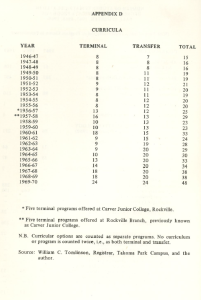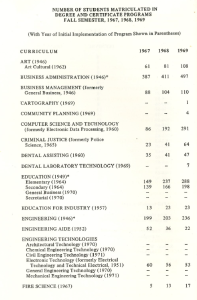Appendix D
CURRICULA
| YEAR | TERMINAL | TRANSFER | TOTAL |
|---|---|---|---|
| 1946–47 | 8 | 7 | 15 |
| 1947–48 | 8 | 8 | 16 |
| 1948–49 | 8 | 8 | 16 |
| 1949–50 | 8 | 11 | 19 |
| 1950–51 | 9 | 10 | 19 |
| 1951–52 | 9 | 12 | 21 |
| 1952–53 | 9 | 11 | 20 |
| 1953–54 | 8 | 11 | 19 |
| 1954–55 | 8 | 12 | 20 |
| 1955–56 | 8 | 12 | 20 |
| *1956–57 | 13 | 12 | 25 |
| **1957–58 | 9 | 14 | 23 |
| 1958–59 | 10 | 13 | 23 |
| 1959–60 | 11 | 12 | 23 |
| 1960–61 | 18 | 15 | 33 |
| 1961–62 | 9 | 15 | 24 |
| 1962–63 | 9 | 19 | 28 |
| 1963–64 | 9 | 20 | 29 |
| 1964–65 | 10 | 20 | 30 |
| 1965–66 | 13 | 20 | 33 |
| 1966–67 | 14 | 20 | 34 |
| 1967–68 | 18 | 20 | 38 |
| 1968–69 | 18 | 20 | 38 |
| 1969–70 | 24 | 24 | 48 |
* Five terminal programs offered at Carver Junior College, Rockville.
** Five terminal programs offered at Rockville Branch, previously known as Carver Junior College.
N.B. Curricular options are counted as separate programs. No curriculum or program is counted twice, i.e., as both terminal and transfer.
Source: William C. Tomlinson, Registrar, Takoma Park Campus, and the author.
Number of Students Matriculated in Degree and Certificate Programs
Fall Semesters: 1967, 1968, 1969
(With Year of Initial Implementation of Program Shown in Parentheses)
| Curriculum | 1967 | 1968 | 1969 |
|---|---|---|---|
| ART (1946) – Art Cultural (1962) | 61 | 81 | 108 |
| BUSINESS ADMINISTRATION (1946)* | 387 | 411 | 497 |
| BUSINESS MANAGEMENT (formerly General Business, 1946) | 88 | 104 | 110 |
| CARTOGRAPHY (1969) | – | – | 1 |
| COMMUNITY PLANNING (1969) | – | – | 4 |
| COMPUTER SCIENCE AND TECHNOLOGY (formerly Electronic Data Processing, 1960) | 86 | 192 | 291 |
| CRIMINAL JUSTICE (formerly Police Science, 1965) | 23 | 41 | 64 |
| DENTAL ASSISTING (1960) | 35 | 41 | 47 |
| DENTAL LABORATORY TECHNOLOGY (1969) | – | – | 7 |
| EDUCATION (1949)* – Elementary (1964) | 149 | 237 | 288 |
| EDUCATION (1949)* – Secondary (1964) | 139 | 166 | 198 |
| EDUCATION – General Business (1970) | – | – | – |
| EDUCATION – Secretarial (1970) | – | – | – |
| EDUCATION FOR INDUSTRY (1957) | 13 | 23 | 23 |
| ENGINEERING (1946)* | 199 | 203 | 236 |
| ENGINEERING AIDE (1952) | 52 | 36 | 22 |
| ENGINEERING TECHNOLOGIES – Electronic Tech (1951) | 60 | 56 | 53 |
| FIRE SCIENCE (1967) | 5 | 13 | 17 |
| GENERAL EDUCATION (1947) – Humanities/Social Sci. (1964) | 802 | 1274 | 1675 |
| GENERAL EDUCATION – Math/Science (1964) | 217 | 226 | 260 |
| GEOGRAPHY (1969) | – | – | 1 |
| HOME ECONOMICS (1949)* | 22 | 13 | 12 |
| LIBERAL ARTS (1946) – Arts Sequence (1964) | 448 | 409 | 502 |
| LIBERAL ARTS – Math/Science Sequence (1964) | 156 | 127 | 177 |
| MEDICAL LABORATORY TECHNICIAN (1969) | – | – | 6 |
| MEDICAL TECHNOLOGY (1947) | 16 | 19 | 29 |
| MENTAL HEALTH ASSOCIATE (1969) | – | – | 21 |
| MUSIC (1946) – Cultural/Professional (1962) | 26 | 26 | 31 |
| MUSIC – Education (1962) | 38 | 29 | 27 |
| NURSING (1966) | 55 | 60 | 76 |
| PHYSICAL EDUCATION (1949)* | 120 | 128 | 129 |
| PRE-DENTISTRY (1946) | 15 | 25 | 25 |
| PRE-LAW (1946) | 30 | 38 | 42 |
| PRE-MEDICINE (1946) | 14 | 26 | 43 |
| PRE-OPTOMETRY (1967) | 3 | 3 | 4 |
| PRE-PHARMACY (1949) | 5 | 10 | 6 |
| RADIATION SCIENCE (1965) / TECHNOLOGY (1961) | 21 | 22 | 19 |
| RADIOLOGIC TECHNOLOGY (1969) | – | – | 1 |
| RECREATION LEADERSHIP (1970) | – | – | – |
| SECRETARIAL (1946) | 190 | 196 | 209 |
| SECRETARIAL CERTIFICATE (1967) | 8 | 6 | 17 |
| VISUAL COMMUNICATIONS TECHNOLOGIES (1966) – Art Advertising (1962) | 103 | 122 | 142 |
| VISUAL COMMUNICATIONS TECHNOLOGIES – Printing Technology (1966) | 35 | 58 | 83 |
*Originally offered under the title of Pre-(curriculum designation).
Source: Office of Institutional Research



Media Attributions
- Growth of Curricular Offerings at Montgomery College, 1946–1970
- Student Enrollment by Degree and Certificate Program, 1967–1969
- Enrollment in Academic Programs by Curriculum, Fall Semesters 1967–1969 (Part 2)
